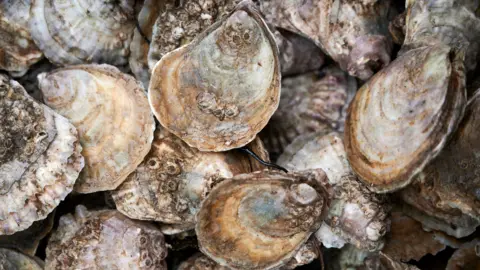Rare oysters being reintroduced to Firth of Forth
 Maverick Photo Agency
Maverick Photo Agency Thirty thousand rare oysters are being reintroduced to the Firth of Forth having been wiped out by overfishing and pollution.
Once native to Scotland, it has been estimated that 30 million European flat oysters were being harvested towards the end of the 1800s.
But by 1957 they were declared extinct in the area.
So far, 14,000 oysters have been reintroduced with plans for the rest to be added by the end of the year.
The project is part of efforts to increase biodiversity in Scottish waters.
It is being led by Edinburgh's Heriot-Watt University and WWF Scotland, along with other partners.
It has so far involved 128 people, a team of marine biologists and a skipper who have put in 500 hours of manual labour.
They also aim to restore four hectares of seagrass as there is a synergistic relationship between the species.
In 2009, a scientist from Stirling University believed she had discovered some of the oysters in the Forth.
However, WWF Scotland said the information had been incorrect and there were no verified records of oysters in the Forth since 1957.
Loch Ryan in Dumfries and Galloway has retained a population of oysters but numbers have vastly reduced everywhere since the 1800s.

Oysters are known as filter feeders and each oyster can filter about 200 litres of water per day. As they filter, they feed on different particles in the water column.
As well as improving water quality, oysters increase biodiversity, which means a surface for seaweeds and other animals to settle on.
Naomi Kennon, Restoration Forth’s research assistant at Heriot-Watt University, said: "They can clean water at an incredible rate compared to some other shellfish so that means if there’s something like an algal bloom, they’ll eat all the algae and the water will be clearer for it."
The oysters can also feed on organic particles, which could potentially come from untreated sewage outflow into the Firth of Forth.
Ms Kennon said that although it was not clear if the oysters would have an impact on an area the size of the Firth of Forth, even a small difference would be beneficial and could improve water quality.
She said oysters and seagrass had "synergistic ecosystem services", as the oysters clear the water as they feed and allow more light to reach the seagrass.
"It would seem sensible to assume there is a connection there, but we don’t know for sure as they are both incredibly rare," she said.
Oyster beds once existed along the east coast of Scotland, including the Firth of Forth and on to the River Dee.
Edinburgh’s connection to oysters are embedded in local songs and stories.
There are tales of the Fishwives of Newhaven and oyster wars where people ventured into each other’s territories.
Ecologist Leoni Anderson is a volunteer from Project Shoreline which partnered with Restoration Forth and wanted to maintain the tradition.
She said: "There are choirs now who keep those memories alive and sing the old songs and when the oyster fishermen went out, they would sing or say incantations.
"The fishermen believed it’s good to sing to the oysters and they would catch them so there was a kind of partnership thing going on, a bit of magical stuff."

The oysters being reintroduced begin their journey at Little Loch Broom in Ullapool, where they travel more than 200 miles to Heriot-Watt University to be processed through biosecurity.
They are scrubbed clean by volunteers to remove any disease before moving to their news homes in the Firth of Forth.
Ms Kennon said: "The volunteer turnout we’ve had has been absolutely incredible, whether that’s been physically cleaning the oysters, sticking oysters to string or to each other.
"It's just been fantastic because we know these oysters will benefit communities and to see that the volunteers so encouraged by what we’re doing and want to help us."
Melanie McAinsh, who has helped to scrub boxes of oysters, said: "I’m a year-round outdoor swimmer, I’ve been in the water all my life, and I’ve had the chance to improve the water in my lifetime, so I had to jump at it.
"It just makes me feel really hopeful."
Ms Arnold added: "We’ve wiped those beds out of existence because of things like overfishing so I think in part we have a responsibility to put them back but will also benefit from the ecosystem services they provide."
